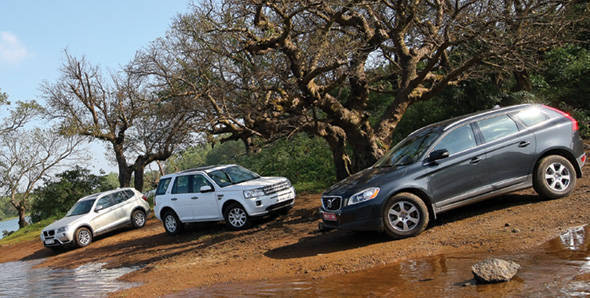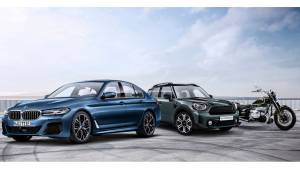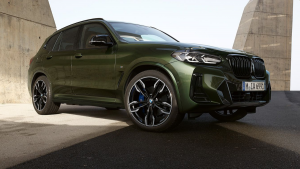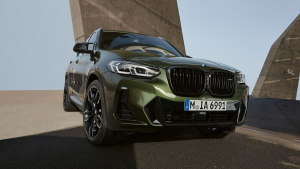Land Rover Freelander 2 vs Volvo XC60 vs BMW X3

Driving large cars can turn even the meekest of men into road raging loonies. Which perhaps explains the reality that a surprisingly large percentage of SUV owners were significantly bullied at some point in their lives. And now they're out for payback, running over lesser mortals in their 'normal' cars. Jokes aside, why buy a big imposing SUV when you're never properly going to use it? Simply put, SUVs make you the king of the road and there's nothing quite as fun as driving a vehicle that screams, 'get out of my way.' The smart folk in big auto companies naturally caught on and hence was born the soft roader. A vehicle with the desirable on-road presence of an SUV but without too many unnecessary go-anywhere trappings. Soft roaders have great on road dynamics where they'd spend most of their time and can go surprisingly far off the beaten path when the odd off-roading bug bites you. And here are three of the finest you can buy today.
Styling and design
All three subscribe to very different schools of design thought. The first thing that hits you about the 2011 BMW X3 in India is its size which is nearly identical to the first gen X5. The X3 is now 83mm longer and 22mm wider than before. The 22mm increase in wheelbase equates to a pleasingly spacious cabin as well. Typical of new age BMWs the design is restrained and Germanic with none of the earlier outlandish Bangle elements. As usual the pronounced kidney grille and corona ring headlamps are the highlights up front. But the headlamps are surprisingly simple rectangular units which allow the considerable bumper and metal finish bash plate to give the x3 a hint of brawn. The side is dominated by the rising shoulder line that runs from the front wheel arch and merges into the tail light. The chrome surrounded window line that tapers upwards to the rear also draws the eye. The rear in my opinion is the best angle on the bimmer with its smart arrow shaped tail lights to the muscular lines on the tail gate and bumper. They say if you've seen one BMW interior you've seen 'em all. 'They' have obviously seen the interiors on the new X3 because there's nothing very different here. Things are simple and straightforward in here. There are ten buttons but they are programmable quick access menu buttons which do make sense when you live with the car daily.
The interiors are a big step up from the old X3 while the controls feel great to use and are rather convenient and user friendly. The seats are wrapped in great looking tan leather and are comfortable over long stretches. The cozy rear bench is nicely contoured into the doors and can comfortably seat three with more than enough leg room. However there are a few gripes. Such as the plastic blanks on the edges of the iDrive screen (which is smaller than the xDrive 30d's unit) that don't feel very premium. Then there's the thin rimmed steering wheel that's unlike the paddle shifter shod fat unit from the 30d. Overall it's a cabin where form takes considerable precedence over function. The Volvo meanwhile throws boring design into the garbage bin. This is a neck snappingly svelte SUV if there ever was one. Right from that sensuous front end to the rising waistline all the way to the deliciously upswept and curvy rear end the XC60 is a real eye catcher. It looks feline and poised to leap ahead. Very few cars command the kind of attention this Volvo does and it is no doubt the sexiest of this trio. The sleek and sexy design continues inside with Volvo's trademark floating centre console which makes an otherwise unremarkable layout suddenly seem amazingly cool. There's intuitiveness all around especially with the human figure for air con controls. The intermix of brushed aluminium and walnut wood makes for a very premium look. We did have a look at another XC with a grey interior, which looked equally sleek but was distinctly gloomier.
An LCD screen atop the console offers myriad vehicle and entertainment information but Volvo could have included a higher resolution screen. The contoured leather seats all around are as comfortable as they look. Despite the swoopy exteriors the Volvo's cabin is the most spacious here. The Volvo XC60 in India has a lot of technology but it looks cluttered with too many buttons. Try switching off ESP. It doesn't have a touch screen so figuring out the scroll takes time. Then you need to figure out the on/off button. The iDrive is far more sophisticated in the menu systems and intuitiveness. Also BMW has much better quality than Volvo. The Land Rover Freelander 2 in India in comparison is the most honest and old school of the three. It carries forward the squared off design theme true to Land Rovers but spruces things up in the finer details. The grille up front for instance is taken off the range topping Range Rovers and adds immense character to the front. The air intake on the side that houses the indicator adds detail to an otherwise bland side profile while the butch rear end is unmistakeable for anything but an SUV. For those of you looking for an immediately identifiable, no nonsense SUV the Freelander 2 will definitely rock your boat. Inside things take an unusual turn with a neat but unconventional cabin layout. On first impressions you'll immediately notice a profusion of buttons and knobs on the centre console. The dash doesn't feel as special as the Volvo's and is more along the same plane as the BMW's. However not everything inside works as you'd like it to. The chunky steering wheel feels at home here but the thin chrome strips that double as horn buttons just don't work for me. You hardly ever hit the horn on the first try and they take a while to get used to. The quirky multimedia interface also takes some acclimatising. Positively though the entire layout feels rugged and reminds you of the vehicles true purpose, but more on that later.
Engines and performance
The xDrive 20d variant we have on test brings a 1995cc four cylinder common rail turbo diesel engine to the table. 184PS of power and 380Nm (between 1750 and 2750rpm) of torque may be the lowest figures here but don't be fooled. This BMW is no slouch and will hit 100kmph from a standstill in 9.4 seconds while top speed is limited to 210kmph. That makes it quicker than both the Volvo and Land Rover. Despite being tested in the wet. But the good stuff doesn't stop there. The X3 is also the most fuel efficient of the three returning an overall figure of 14.02kmpl. How does the BMW manage this simultaneous cake having and eating? Well it's mostly down to the excellent 8-speed ZF automatic transmission. Quick, smooth and precise shifts are this box's forte and it makes this Bimmer quite a joy to drive. The fact that this car is 25 kilos lighter than the previous gen X3 also helps. The unobtrusive start stop system helps save those precious drops fuel as well.
With 205PS (4000rpm) on tap the five cylinder twin turbo Volvo D5 engine is the most powerful in this group. The 420Nm of torque is on par with the Freelander 2 but is produced at a lower 1500-3250rpm compared with the LR's 1750rpm. A low pressure turbo provides poke and quick engine response times at lower speeds. The second high pressure blower steps in at higher revs for a smoother and more gradual build up of boost when needed and less intrusive turbo kick. The engine feels smooth and refined at low revs but gets rather vocal as the speed/revs rise and isn't quite as smooth an operator as the BMW mill. On its own, the 6-speed auto in the Volvo would be a good unit but when compared with the BMW's 8-speed affair it loses out. Shifts aren't half as quick and you have to plan overtakes keeping in mind the lag between asking for a downshift and actually getting one. The punchy engine, slightly let down by the gearbox sprinted to the ton in 9.75 seconds and hit a top speed of 205kmph, negligibly slower than the X3. However, efficiency figures were the lowest in this test at 8.22kmpl overall, marginally less than the Freelander 2.
The Freelander 2 gets a 2179cc four cylinder diesel engine that produces 190PS of power at 3500rpm and 420Nm of torque at 1700rpm. Power is channelled to all four wheels via a 6-speed automatic transmission. Once again the gearbox cannot match the BMW unit when it comes to shift speed. We managed a 0-100kmph time of 9.92 seconds while the Freelander 2 hit a top whack of 196kmph. Highway mileage at 11.96kmpl was lower than the XC60's 14.3kmpl however the Freelander made up for it with a figure of 7.4kmpl in the city for an overall figure of 8.54kmpl. The Freelander 2 is available in two engine power options - 150PS or 190PS.
Ride quality and handling
Until very recently, BMW's company slogan was "The ultimate driving machine" and they couldn't have put it any better. Their cars were famed (infamous?) for arm wrenching steering and lumbago inducing suspension that worked beautifully on smooth roads or race tracks. In fact the previous gen X3 was an often quoted example of a bimmer with rock hard ride. The effects however were detrimental on anything less than average roads with the car and occupants being pitched around on rough and broken sections. The new car is a revelation in that respect.
The steering amazingly was the lightest of the three at parking speeds. Push the car hard and you discover body roll! It took me quite a while to come to terms with a BMW whose steering could be twirled with a single finger and that rolled through fast corners. But it was clear that this has worked in favour of the car for our conditions. It's now an unstressed and comfortable ride that doesn't make your arms ache and lose you your friends after every drive. The softer ride absorbs mid corner bumps better so the car actually grips better. In fact ride quality has improved so much that we actually double checked whether the car sports run flat tires which ordinarily impact ride quality. Turns out the X3 still does, but you'd never guess it. The steering weighs up nicely at speed as well and the car feels very stable at high speeds. The X3 has more body roll than before but still nowhere near what the other SUVs have. The X3 is based on a monocoque chassis based on the Touring version of the 3 series. The engine is a longitudinally mounted unit which powers all four wheels. The adaptive four wheel drive system analyses data like speed, steering angle and torque output and sends power to the right wheels to keep the car in line. However it does send more power to the rear wheels during steady cornering to keep the famed BMW rear wheel drive feel alive. The X3 gets adaptive suspension as standard which lets the driver choose from Comfort, Sport and Sport+ modes. Comfort mode has the car feeling soft and cushy while Sport and Sport+ firm things up nicely and reduces roll considerably without making the car painfully stiff. It's clear the company's cars are progressing along with their slogans as this car really is pleasant to drive.
The Volvo is slightly better than the BMW when it comes to the driving experience. The XC60 gets MacPherson struts up front and multilink suspension at the rear. The car is stiffly sprung which means that you will feel bumps but you won't be disturbed by them as the damping takes care of the harshness. The negative on-road aspects of the high ground clearance of 230mm are nullified by the low centre of gravity which ensures good handling with limited roll. Three drive modes, namely Comfort, Sport and Advanced are on offer and they work similarly to the drive modes in the BMW. The XC60 attacks corners with great steering feel and plenty of grip from the four wheel drive system. The steering weighs up nicely without feeling artificial and body roll is controlled well in advanced mode. The BMW is the better compromise for India and is evenly matched with the Volvo when it comes to sportiness.
The Freelander 2 is the best of this lot when the roads cease to exist. Don't get me wrong, it still has good road manners, just not as polished as the Volvo and BMW. The Freelander is also based on a monocoque chassis with independent suspension all around. At slower speeds the steering feels heavy like you'd expect with a brawny SUV however at high speeds it starts to feel loose and fidgety which doesn't inspire too much confidence. Body roll also is the most pronounced of the three. But it is also the oldest in this lot and it shows its age with its old school driving manners. Get off the road and the Freelander comes into its own. This baby Land Rover will go considerably further down the unbeaten path and will keep going long after the other two have given up. Credit for that goes to Land Rover's famed Terrain Response system that enables it to crawl through almost anything that you throw at it. The system lets you choose from four modes, namely tarmac, grass/gravel/snow, mud-ruts and sand. What these modes do is set up the car for varying situations and shuffle torque from front to rear, play with different settings and more. This ensures the Freelander has just the right amount of power at the right wheels to deal with various situations and varying traction levels.
The other two cars come with adaptive four wheel drive systems that send power where it is needed. Despite that and the fact that all three come with off road features like hill descent control they meet their limits quite before the Land Rover. Nevertheless they both can handle more than a fair amount of off-roading and are sufficient for a bit of weekend fun. How many people will actually want to put their near fifty lakh rupee vehicles through such abuse is another question all together.
Safety and Features
All three vehicles are stuffed to the brim with every feature you'd expect at the price point. Which is why electric seats, cruise control, xenon headlamps, a battery of airbags, parking sensors, tyre pressure monitoring systems and more feature on all three. Each also gets a sun roof however the Land Rover gets only a cloth shade that lets quite a bit of heat seep into the cabin. This forces the aircon into working overtime which only leads to lower fuel efficiency. In terms of safety the Land Rover gets Roll Stability Control which does what the name suggests by braking the outer wheels to cut down roll in hard cornering. There's also cornering brake control (CBC) and dynamic stability control (DSC) on offer. The BMW gets a great sounding 12 speaker, 6 DVD changer entertainment system with full Bluetooth and USB connectivity. My android phone connected seamlessly to the system and I was able to play music off the phone in less than two minutes. Keeping occupants safe are dynamic stability control, active head rests, which move forward in a collision to minimise neck and spine injury, and a crash sensor which disables the central locking and shuts off the fuel pump post impact. While the other two are like well stocked refrigerators the Volvo is more like a fully furnished bunker that will keep you happily sustained through a nuclear winter. The feature list is expansive and the safety register, even more so.
The XC60 is the only car here to offer a powered tailgate. There's a twelve speaker audio system from Dynaudio that's heavy on the bass and about just as good as the BMW unit. There's an automatic leveling system that adjusts the cars suspension to maintain its ground clearance when fully loaded. There's also a roll over stability program and a stability control package as on the Freelander. The Volvo's adaptive cruise control is a marvel. It automatically slows down the vehicle when it senses slower moving traffic ahead and accelerates back to the set speed when the course ahead is clear. The car projects red lights on the windscreen that are a proximity warning system. They function independent of the adaptive cruise and warn you if you're getting too close to the vehicle up front.
The XC 60 has a new technology called City Safety to prevent collisions. When driving in the city, up to speeds of 30kmph, the Volvo detects whether a collision is likely. If it is likely then the XC 60 will indicate it and if it gets no response then will automatically brake to avoid the collision. Then there's the BLIS or blind spot warning system which alerts you of vehicles in your blind spot with lights built into the A pillars on either side of the car. The system engages above 10kmph and can identify any vehicle from motorcycles and up.
The car can decide whether you're tired or distracted by monitoring your driving pattern and it alerts you with an audible warning and a message in the instrument panel. Drift erratically in and out of your lane and the lane departure system will slap you across the wrists with a warning beep. However the system will not take offence if you use your indicators. Then there are active bending lights and active brake lights that flash four times a second under hard braking to warn road users behind you. The list goes on. All of these safety features give it a five-star Euro NCAP rating, the same as the X3 and the Freelander.
Final word
The Land Rover Freelander 2 price in India is significantly cheaper than the others with a starting price of Rs34.69 lakh (all prices, ex-showroom Mumbai) although the HSE on test here retails at Rs40.40 lakh. The BMW and Volvo are nearly on par with the 2011 BMW X3 price in India coming to Rs41.35 lakh and the Volvo XC60 price in India at Rs41.41 lakh. The Freelander will take you to the horizon and beyond without complaining. We are looking at SUVs that offers good intra-city and inter-city travel where this Land Rover fits the bill but it's not on the same scale of comfort, dynamics and luxury as the BMW or the Volvo. Things get confusing thereafter. The XC60 plays the same gambit the brand uses in Europe today. A sexy, smart SUV loaded with an unbelievably long list of safety related features, all of which work even in our chaos at a competitive price. But the X3 nudges ahead when it comes to fuel efficiency, almost 6kmpl more than the XC 60. Also the engine feel, dynanics, steering feel and performance are better in the X3. Add to that a sparse Volvo dealer and service network compared to BMW which has the largest dealer and service network in this lot, and the BMW crosses the finish line in front of the XC 60. Just in front though.
Starts Rs 61.9 Lakhs
1969cc
Automatic
254
350
12.15 Kmpl
Starts Rs 59.9 Lakhs
1998cc
Automatic
252
350
13.17 Kmpl
-NA-
2179cc
Automatic
-NA-
420
12.39 Kmpl
Related Stories
Top Stories
Latest Videos
Most Popular
Network18 Updates














